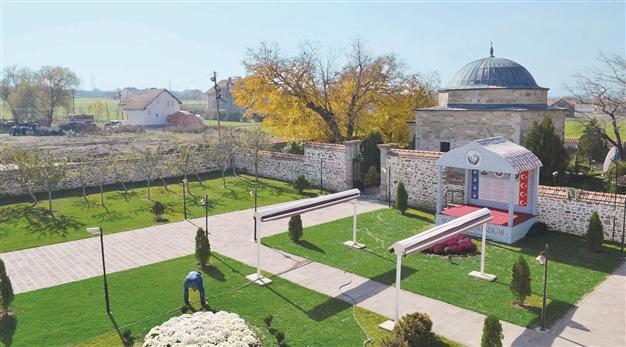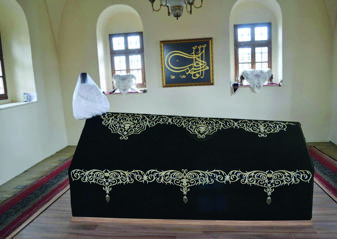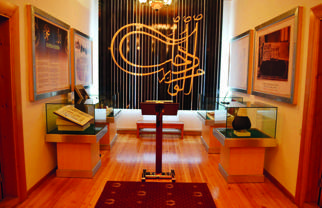A sultan’s tomb off the beaten track
BEATRICE WHITE ISTANBUL - Hürriyet Daily News

In a field on the outskirts of the Kosovan capital of Pristina lies the tomb of Sultan Murad I (Meşhed-i Hüdavendigâr). The area surrounding the tomb is where the Battle of Kosovo took place in 1389, when the Ottoman Empire’s military forces led by the sultan met an allied army formed of Christians living in the Balkans, consisting of Serbs, Croats, Bosniaks and Albanians, under the command of Serbian Prince Lazar.
Although the Ottomans emerged victorious at the end of a grueling eight-hour battle, the triumph was marred by the Sultan’s death. It is recounted that, while walking through the battlefield to survey the carnage in the wake of the victory, Murad was suddenly and fatally stabbed by the Serbian soldier Milos Obilic, who had been injured in the battle but was still alive at the moment when the sultan was passing by. Murad’s son, Yıldırım Bayezid, who was at his side at the moment of his death, became his father’s successor only moments later. While the sultan’s body was embalmed and taken to Bursa to be buried there, the internal organs remained in Kosovo and the tomb was built for the purpose of housing these and commemorating the sultan on the battlefield.
The outcome of the battle, Murad’s fourth in an undefeated streak, marked the beginning of both the Ottoman presence in the Balkans and a long and bitter struggle with the empire’s detractors in the region. As the oldest Ottoman building in Kosovo, the tomb is emblematic of this new era.
 A hidden heritage
A hidden heritageSituated a short walk from the highway linking Pristina with the town of Mitrovica, the tomb’s site is somewhat inconspicuous, with no signs on the main road to indicate its presence. The small but well-groomed grounds surrounding the tomb also house a graveyard, a small house for the caretaker of the tomb and a large house that has been converted into a museum.
Both the tomb and museum underwent extensive renovation in 2005 and continue to be supported by the Turkish Cooperation and Development Agency (TIKA) in collaboration with the Directorate of Religious Affairs (Diyanet). TIKA, a government agency established to foster relations with countries that share historical ties with Turkey, and often are home to a significant number of people of Turkish origin and Turkish-speakers, carries out projects in many countries in the regions in the framework of Turkey’s foreign relations policy.
The museum aims to provide visitors with the historical background to the battle and also contains a number of artifacts dating back to the time of Murad I. Information provided is in three languages: Albanian, Turkish and English. The building in which it is housed, built in 1896, had previously served as accommodation for travelers.
Muamer Sivrikoz Hasani works as a guide at the museum. He says the tomb receives visitors from many different countries, mostly Turks but also even Japanese people.
In the garden just outside the tomb are the graves of the previous tomb caretakers (türbedar), a profession handed down through the generations for centuries. The function is still being carried out today, by the current caretaker Saniye Türbedar. Originally Bosniak by ethnicity, she took over the role from her husband after he passed away. As per tradition, she lives on site, in a small house just behind the tomb. When she married her husband she became part of a family that has been taking care of the tomb since 1854.
 Caught in between
Caught in betweenAs a Kosovan citizen of Turkish descent, Hasani is in the delicate position of embodying different identities that have not always co-existed harmoniously. He feels that despite the shared history and the strong presence of Turkish culture and language in the country, the communities suffer from a lack of understanding of one another. “Ottoman history is unfortunately not seen in a very objective way, and this is not just in Kosovo but in all of the Balkans,” he says.
This is something which Hasani feels has improved over time, however, and he seems optimistic that relations between Turkey and the recently founded nation will continue to improve. “I think Turkey has changed, and with that has changed also the perception of us [Kosovans] for Turkey, especially over the last 10 years the image of Turkey had totally changed, and this has come as a result of a very dynamic foreign policy of Turkey,” he says. “Now, Kosovo is on Turkey’s agenda – political, economic, social, etc.”
Hasani also feels Turkey’s support for the country has been crucial in helping it to stabilize following its turbulent beginnings, recalling that “Turkey, together with the USA, were the first countries that recognized the independence of the newest country in Europe, for which people of Kosovo will be forever grateful.” Kosovo declared itself as an independent state following a protracted campaign to break away from Serbia which claimed thousands of lives. At the height of the violence in the late 1990s, a NATO intervention was launched. By great fortune, the tomb was spared damage by the bombs and fighting which devastated much of the surrounding area during the 1990s. Turkish Prime Minister Recep Tayyip Erdoğan visited the tomb in 2010.
Among the headstones and fountains surrounding the tomb is a striking sight that never fails to catch the eye of visitors. An enormous, imposing blackberry tree, which has been split straight down the middle of its thick trunk and now leans perilously to either side, supported by the walls behind it.
Thought to be 300 to 400 years old, it split in two as it grew and became so heavy it could no longer support its own weight, explains Hasani. “For 20 years it has not been giving fruit because it got old but also because of the air pollution - as you see there are two thermal stations nearby…”
In a bid to save the tree, the crack was sealed up with a grey-colored paste to prevent it from rotting from the inside, and great care has been taken to tend to it and help it to survive. Still standing but in a severely weakened state, the majestic tree serves as a poignant reminder that even the most towering of figures can be cut down, and might itself can sometimes prove to be a fatal weakness.
 In a field on the outskirts of the Kosovan capital of Pristina lies the tomb of Sultan Murad I (Meşhed-i Hüdavendigâr). The area surrounding the tomb is where the Battle of Kosovo took place in 1389, when the Ottoman Empire’s military forces led by the sultan met an allied army formed of Christians living in the Balkans, consisting of Serbs, Croats, Bosniaks and Albanians, under the command of Serbian Prince Lazar.
In a field on the outskirts of the Kosovan capital of Pristina lies the tomb of Sultan Murad I (Meşhed-i Hüdavendigâr). The area surrounding the tomb is where the Battle of Kosovo took place in 1389, when the Ottoman Empire’s military forces led by the sultan met an allied army formed of Christians living in the Balkans, consisting of Serbs, Croats, Bosniaks and Albanians, under the command of Serbian Prince Lazar.  A hidden heritage
A hidden heritage Caught in between
Caught in between